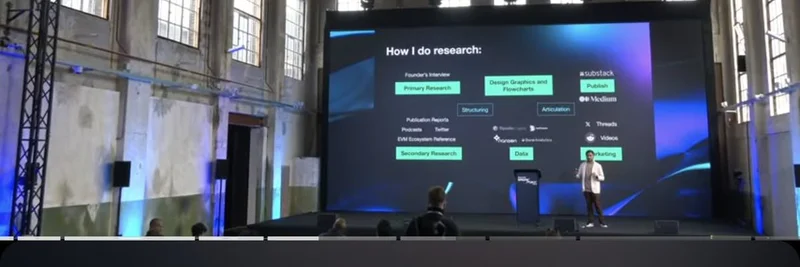In the fast-paced world of cryptocurrency, debates about which projects will dominate institutional adoption are always buzzing. A recent tweet from The Rollup has reignited the conversation around Chainlink ($LINK) versus XRP, featuring insights from Zach Rynes, better known as @ChainLinkGod, Chainlink's Community Liaison. This clip from their podcast highlights why Chainlink seems to be outpacing XRP when it comes to real-world institutional use cases. But what does this mean for meme token enthusiasts? Let's dive in.
The Core of the $LINK vs $XRP Debate
The tweet shares a video clip where Rynes breaks down the long-standing rivalry. For years, XRP—powered by Ripple—has positioned itself as the go-to for banks and cross-border payments. The narrative was simple: XRP would revolutionize how financial institutions handle transactions, with whispers of secret NDAs and impending mass adoption.
However, as Rynes points out, the reality has been different. "Since Ripple was a thing, that was always XRP's narrative that XRP would be the ones working with the banks," he says. But major players like SWIFT and JP Morgan have publicly announced partnerships with Chainlink instead. "SWIFT comes out and says, we're using Chainlink for this, JP Morgan comes out and says, we're using Chainlink for this," Rynes explains. In contrast, "XRP's core product just has not seen meaningful traction with institutions."
Chainlink, on the other hand, acts as an oracle network. In simple terms, oracles are like bridges that feed reliable, real-world data (like prices or events) into blockchains, making smart contracts smarter and more usable. This tech has proven indispensable for decentralized finance (DeFi) and beyond, attracting big institutions that need secure data feeds.
Check out the full tweet and clip here to hear it straight from the source.
Why Institutions Are Flocking to Chainlink
Institutions aren't just talking about Chainlink—they're using it. Rynes highlights how Chainlink has been quietly building real partnerships over the past seven years, without relying on hype or hidden deals. Entities like UBS and SBI have also jumped on board, publicly endorsing Chainlink's tech stack.
This shift matters because institutions prioritize reliability, security, and proven results. Chainlink's decentralized oracle network minimizes risks like data manipulation, which is crucial for high-stakes financial applications. XRP, while efficient for payments, hasn't captured the same level of institutional buy-in, partly due to regulatory hurdles like the SEC lawsuit that dragged on for years.
For blockchain practitioners, this underscores a key lesson: real adoption comes from solving tangible problems. Chainlink's approach has positioned it as a foundational layer for the entire crypto ecosystem, including areas where meme tokens thrive.
How This Affects Meme Tokens and the Broader Ecosystem
At Meme Insider, we're all about meme tokens—the fun, viral side of crypto that often starts as jokes but can evolve into serious projects. So, how does Chainlink's institutional win impact the meme token space?
Many meme tokens rely on Chainlink's oracles for essential functions. For instance:
- Price Feeds: Accurate, tamper-proof price data is vital for decentralized exchanges (DEXs) where meme tokens trade. Without reliable oracles, trading could be chaotic or exploitable.
- Verifiable Random Function (VRF): Used for fair lotteries, airdrops, and NFT mints in meme communities. Imagine launching a meme token giveaway without worrying about rigged outcomes—Chainlink makes that possible.
- Automation: Chainlink Keepers automate smart contract tasks, helping meme projects run smoothly, like triggering events based on real-world data.
With heavyweights like JP Morgan and SWIFT backing Chainlink, it adds a layer of credibility and stability. This could lead to more institutional money flowing into DeFi, indirectly boosting meme token liquidity and innovation. Plus, as Chainlink grows, its tech becomes even more accessible for small-scale meme projects, helping them scale without breaking the bank.
If you're building or investing in meme tokens, keeping an eye on Chainlink integrations could give you an edge. Projects like Dogecoin or newer memes often intersect with DeFi, where Chainlink plays a starring role.
Community Reactions and Ongoing Buzz
The tweet sparked lively discussions in the replies. Some users, like @Krip_Dough, argued that $LINK should match or exceed $XRP's market cap given its traction. Others, such as @cjay209_, defended XRP, noting it's more about settlement layers than oracles—they solve different problems.
There were humorous takes too, with @justubongxyz comparing XRP to showing up at a party with dreams, while Chainlink brings the DJ and contracts. On the flip side, XRP supporters like @AamAR1997 pointed to the SEC lawsuit as a major setback, questioning if the FUD is just jealousy.
This back-and-forth shows the passion in crypto communities, especially around established players like $LINK and $XRP. It also highlights how narratives can shift as real-world adoption takes center stage.
Wrapping Up: A Win for Blockchain Reliability
Zach Rynes' insights remind us that in crypto, hype only goes so far—real partnerships and utility win the day. Chainlink's edge in institutional appeal not only strengthens its position but also bolsters the entire blockchain ecosystem, including the vibrant world of meme tokens.
If you're a meme token creator or trader, consider how integrating trusted oracles like Chainlink can elevate your project. Stay tuned to Meme Insider for more updates on how traditional finance intersects with the wild side of crypto. What's your take on the $LINK vs $XRP debate? Drop your thoughts in the comments!

